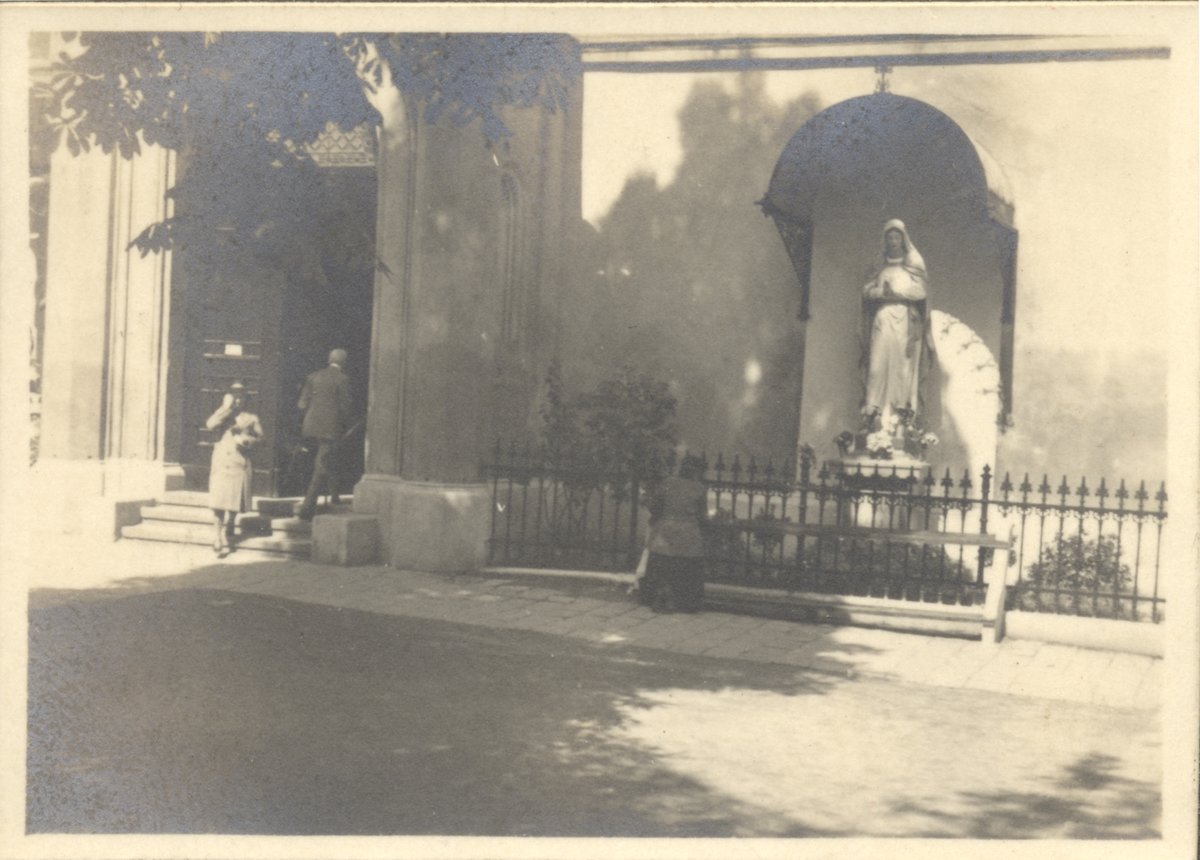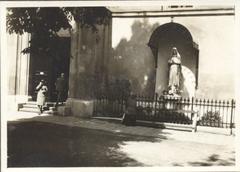
Saint Elizabeth of Hungary Church: Visiting Hours, Tickets, and Historical Significance in Alsó-Víziváros, Budapest
Date: 15/06/2025
Introduction: The Church and Its Cultural Importance
Saint Elizabeth of Hungary Church in Alsó-Víziváros, Budapest, stands as a powerful symbol of faith, charity, and Hungarian heritage. Dedicated to Saint Elizabeth, a 13th-century princess celebrated for her compassion and devotion to the poor, the church is both a spiritual haven and an architectural gem. With its striking blend of Baroque and Neo-Gothic influences, the church is a focal point for visitors seeking to understand Budapest’s religious and cultural tapestry. Its proximity to the Danube and other historic landmarks enhances its significance as a must-visit destination in the Hungarian capital (justbudapest.com; Franciscan SFO).
Historical Background
Saint Elizabeth of Hungary: Origins and Legacy
Born in 1207 to King Andrew II and Queen Gertrude of Merania, Elizabeth was betrothed at a young age and moved to Thuringia, Germany. Despite her royal upbringing, she became renowned for her humility and unwavering dedication to the sick and poor. Elizabeth’s acts of charity—most notably the legendary “miracle of the roses,” where bread she was carrying to the poor was miraculously transformed into roses—cemented her reputation as a model of Christian virtue. She was canonized in 1235, just four years after her death, and has since been venerated throughout Europe (justbudapest.com; Franciscan SFO).
Founding and Evolution of the Church
Situated in the historic Alsó-Víziváros district (“Lower Watertown”) on Budapest’s Buda side, Saint Elizabeth of Hungary Church reflects centuries of spiritual devotion. While the exact date of its foundation is not precisely documented, the church is rooted in the Hungarian tradition of commemorating Saint Elizabeth with sacred spaces that serve both the faithful and the broader community. Its location near the Danube and other major sites underscores its role as a vibrant center of worship and local identity (opentripmap.com).
Architectural and Artistic Heritage
Design and Influences
The church’s architecture is a harmonious blend of Baroque and Neo-Gothic elements, a testament to the evolving styles of Budapest’s ecclesiastical buildings. Designed by Imre Steindl, famed for the Hungarian Parliament Building, the church draws inspiration from St. Elizabeth’s church in Marburg, Germany, where the saint’s relics are enshrined (ferenc2023.hu; pestbuda.hu).
Exterior and Interior Features
The church’s facade boasts twin towers with distinctive onion domes, intricate stonework, and statues of saints—including Saint Elizabeth herself. Richly decorated entrances, arched windows, and sculpted pediments enhance its visual appeal. Inside, visitors will find a wide nave adorned with frescoes that narrate the saint’s life and biblical scenes, a Baroque high altar, and beautiful stained-glass windows that bathe the sanctuary in colored light (justbudapest.com; Wikivoyage: Budapest/Víziváros).
Artworks and iconography throughout the church celebrate Elizabeth’s charitable deeds—depicting her distributing bread, caring for the sick, and performing miracles. The rose motif is especially prominent, symbolizing her legendary miracle and enduring compassion.
Historical and Spiritual Significance
Saint Elizabeth Church is a central figure in Budapest’s religious landscape, emphasizing her status as a patroness of Hungary and a symbol of Christian charity. The church’s location near the Fisherman’s Bastion and Matthias Church enhances its status as a pilgrimage and tourist site. It serves the local Catholic community with regular liturgical celebrations, charitable outreach, and cultural events, reflecting its dual function as a place of worship and a living monument to Hungarian identity (opentripmap.com).
Visiting Information
Opening Hours
- Monday–Saturday: 9:00 AM – 6:00 PM
- Sunday: 12:00 PM – 6:00 PM
- Hours may change on religious holidays and for special events. Check the official website or parish office for updates.
Admission and Tickets
- Entry: Free
- Donations: Appreciated to support maintenance and charitable work
Accessibility
- Wheelchair access: Ramps at main entrance and accessible restrooms
- Assistance: Available on request for visitors with mobility challenges
Guided Tours and Special Events
- Guided tours: Available on weekends at 11:00 AM and 3:00 PM, or by appointment. Tours offer insight into the church’s history, art, and Saint Elizabeth’s legacy.
- Special events: Regular concerts, liturgical celebrations, and community events—especially around Saint Elizabeth’s feast day (November 17).
Photography
- Allowed: Inside and outside the church
- Guidelines: Avoid flash during services and respect the privacy of worshippers
Getting There and Nearby Attractions
- Location: Alsó-Víziváros (Buda side), Rózsák tere (“Roses’ Square”)
- Public Transport:
- Metro: M2 line to Batthyány tér station
- Trams: 19, 41
- Buses: Several routes serve the area
- Parking: Limited but available nearby
Nearby Sights
- Fisherman’s Bastion
- Matthias Church
- Buda Castle
- Danube promenade
- Jewish Quarter and Great Synagogue (in Pest)
Miracles, Legends, and Artistic Symbols
The Miracle of the Roses
The most celebrated legend is the “miracle of the roses.” When Elizabeth was caught secretly carrying bread for the poor, the bread miraculously turned into roses, symbolizing her divine favor and compassion. This motif is present throughout the church’s art and rose gardens (pestbuda.hu).
Art and Iconography
Saint Elizabeth is depicted with symbols such as:
- Three crowns: Virgin, wife, widow
- Roses and bread: Charity and the miracle
- Basket or pitcher: Almsgiving
- Hospital or castle model: Her role as a hospital founder (Franciscan SFO)
Preservation and Modern Role
Ongoing restoration ensures the church’s architectural and artistic treasures are preserved. The church remains a vibrant center for worship, pilgrimage, and community outreach—continuing Saint Elizabeth’s legacy through charitable initiatives and social programs (ferenc2023.hu).
Frequently Asked Questions (FAQ)
Q: What are the visiting hours for the church?
A: Monday–Saturday: 9:00 AM – 6:00 PM; Sunday: 12:00 PM – 6:00 PM.
Q: Is there an entrance fee?
A: Entry is free; donations are welcome.
Q: Are guided tours offered?
A: Yes, weekends at 11:00 AM and 3:00 PM, and by appointment.
Q: Is the church accessible for people with disabilities?
A: Yes, ramps and accessible restrooms are available.
Q: Can I take photographs?
A: Yes, but avoid flash and be respectful during services.
Q: What are nearby attractions?
A: Fisherman’s Bastion, Matthias Church, Buda Castle, Danube promenade, and Jewish Quarter.
Q: When is Saint Elizabeth’s feast day?
A: November 17 (Roman Catholic tradition); celebrated with special services and charitable events.
Plan Your Visit
Saint Elizabeth of Hungary Church offers a unique experience at the crossroads of faith, history, and architecture. Whether you seek spiritual enrichment, historical insight, or artistic inspiration, the church welcomes all visitors. Combine your visit with nearby landmarks for a fuller appreciation of Budapest’s heritage.
For the latest information on opening hours, tours, and events, consult the official website or download the Audiala app. Stay connected via social media for updates and cultural programming.
Sources
- justbudapest.com
- Franciscan SFO
- ferenc2023.hu
- Wikivoyage: Budapest/Víziváros
- pestbuda.hu
- budapest.city
- opentripmap.com
- St. Elizabeth of Hungary biography
- saintelizabethchurch.com








































































































































































